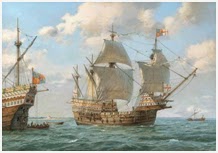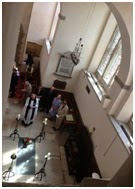My
12th and last blog. It has been an amazing and wonderful sabbatical.
Ki and I have travelled over 20,000 miles and have been away from home for 7 of
the 12 weeks. Highlights of the summer have included my granddaughter’s
baptism, singing on Broadway, Carnegie Hall and the Great Cathedral Church of
St John the Divine, New York, observing beavers in Lake Manatoulin, Ontario,
eating maple and walnut ice-cream in downtown Toronto, meeting Russ Thomas, a
visit to The Mary Rose, as well having wonderful family meals in the sizzling
hot sunshine of Bordeaux. And all this in the context of a remarkable hot summer
which embraced The World Cup, the Yorkshire Tour de France, Wimbledon, The
Commonwealth Games and the rise of the very talented golfer Rory McIIroy.
 I
am writing this blog two days after the nation observed the commemorations of
the start of the 1st World War. The 6th August is one of my
favourite feast days in the church’s year, the Feast of the Transfiguration. It
is a story and picture that brings me back home, to Durham and Tom Denny’s
beautiful and startling stained glass window of The Transfiguration in the
Cathedral. But alas, the feast day also shares another anniversary, the Enola
Gay over Hiroshima. A cloud of dazzling light. The transfiguring in a weapon of
mass destruction.
I
am writing this blog two days after the nation observed the commemorations of
the start of the 1st World War. The 6th August is one of my
favourite feast days in the church’s year, the Feast of the Transfiguration. It
is a story and picture that brings me back home, to Durham and Tom Denny’s
beautiful and startling stained glass window of The Transfiguration in the
Cathedral. But alas, the feast day also shares another anniversary, the Enola
Gay over Hiroshima. A cloud of dazzling light. The transfiguring in a weapon of
mass destruction.
The
strange story of the transfiguration reveals a dazzling light, but yet a cloud;
there is revelation yet things are hidden; a voice, but we do not know what was
truly heard. All very ambiguous – the revealed remains hidden, the
extraordinary appears in the ordinary, and like Elijah’s experience, God
reveals himself in the silence. The transfiguration story ends when Peter
speaks; the end of silence breaks the spell.
As
I gather up my final reflection through the thoughts of the blogs I have
written for the community at Crook, family and friends, listening has been one
of my goals of the summer, listening for God for perhaps a new direction as I start
my retirement years, listening on the white sun-kissed Bordeaux beaches,
listening in the forest wilderness of Northern Ontario, listening in French chantry
chapels. In the words of the famous song we learn to listen to “the sound of
silence.” Deep prayer is founded on the discipline of deep listening. As I
think of the new building project soon to get underway at Jesmond URC,
Newcastle I wonder whether it was really Peter’s intention to interrupt the
spectacular and awesome vision of the Transfiguration with a building project –
“let us build three booths?” Typical, you might think. To every epiphany or
revelation there is someone on hand to turn into a religion. This suggestion is
rejected by Jesus – it shows a remarkable lack of understanding by Peter. “Let
me enshrine the experience,” says Peter, “let us make a memorial, let me speak,
let me build!” But Peter is required to do only one thing: watch and say nothing.
Listen. It is interesting, isn’t it, that the moment Peter speaks, “a cloud
overshadowed them.” And then Peter spoke only because he didn’t know what to
say. The story of the transfiguration is about learning to live with the cloud and the light, and learning that the
voice of God comes in quiet ways.
In
the stillness and restraint of the sabbatical and with the overall thoughts of
these 12 blogs marinating in the background of my mind can I detect the
stirrings of God – as I wait so am I directed?
With the first letter of my Christian name in mind here are three “Rs”
which as a result of the experiences of this sabbatical I hope will direct my
ministry in my retirement years.
First,
Relax. Blog 4 again. I am not
indispensable! As I think about returning to ministry in a country and a local
pastorate where the vast majority of the population continue to affirm their
belief in God and then proceed to do very little about it, I have observed
there is still a demand for religion that is public, performative and pastoral
and that there are thousands of private spiritualities and beliefs that
flourish, demonstrating that faith as statistics may reveal otherwise, does not
wither and die in our culture. Rather religion mutates and lives on. So
churches need to take advantage of this trend, to be open to the world and not
closed to it. And in this regard the sacrament of baptism in my local situation
must be offered as publicly and freely as possible, the answer to indifference
is not restriction; baptism is a point of entry for the church, not the
culmination of an education.
Second, Resilience. I believe that the
Christian faith is remarkably resilient in the modern age, religion is still in
demand. And again the church at the local level must continue to engage with
the community offering shape, colour and articulation to the gospel stories. In
an age of wars of religion, where religion is turning into the new global
politics the church must be there provide comfort, understanding and support to
the confused and bewildered.
Thirdly,
Respond. The church it seems to me
as I think of my local church can respond to the challenge of an apparently faithless
age with a confidence in a society that refuses to leave religion alone. We
continue to offer a ministry and a faith to a public that wish to relate to
religion without necessarily belonging to it. And of course with rare
exceptions this is what ministers have had to work with most of the time; it is
both an opportunity and a challenge.
So
there we have it. Some thoughts then for the future – relax; have faith in the
resilience of God and his church; but also respond to the many tests of faith
that dominate every age. But above all keep listening in prayer to the whispers
of God in the quietness of your soul.
Ray Anglesea
Sabbatical Blog 12:
Transfiguration
August
2014











